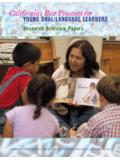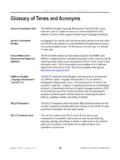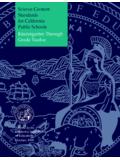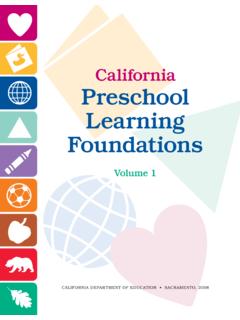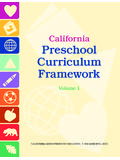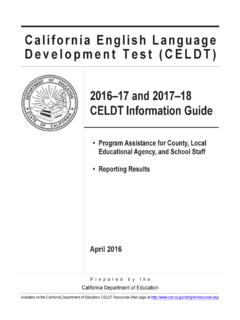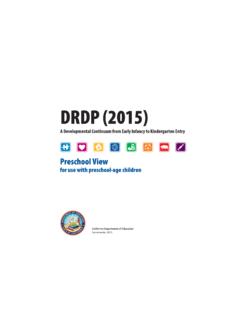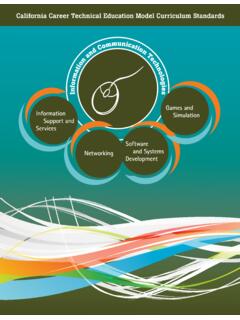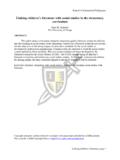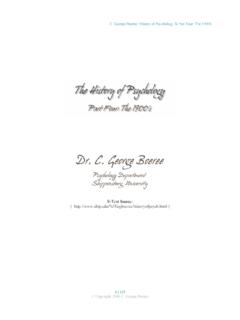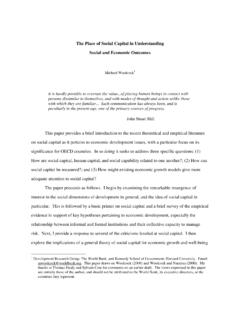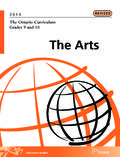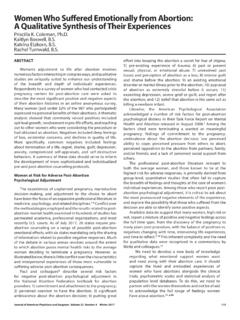Transcription of B D Public Schools U Kindergarten Through - …
1 R D. history social Science O F. A. Content Standards ED. O for California U. B Public Schools Kindergarten Through C. Grade Twelve Adopted by the California State Board of Education October, 1998. California Department of Education Created May 18, 2000. T OF. EN ED. U. TM. CA. AR. T IO. DEP. N. ST. IA. A. Publishing Information N. TE R. FO. OF C A LI. When the history social Science Content Standards for California Public Schools , Kindergarten Through Grade Twelve was adopted by the California State Board of Education on October 9, 1998, the members of the State Board were the following: Yvonne W. Larsen, President; Robert L. Trigg, Vice-President; Marian Bergeson; Timothy C. Draper; Kathryn Dronenburg; Marion Joseph; Marion McDowell; Janet G. Nicholas; Gerti B. Thomas; Marina Tse; and Richard Weston. This publication was edited by Bob Klingensmith, working in cooperation with Greg Geeting, Executive Director, and Gregory F.
2 McGinity, Education Policy Consultant, State Board of Education. It was designed and prepared for printing by the staff of CDE Press, with the cover and interior design created and prepared by Cheryl McDonald. Typesetting was done by Jamie Contreras. It was published by the Department of Education, 721 Capitol Mall, Sacramento, California (mailing address: Box 944272, Sacramento, CA 94244-2720). It was distributed under the provisions of the Library Distribution Act and Government Code Section 11096. 2000 by the California Department of Education All rights reserved ISBN 0-8011-1488-8. Special Acknowledgment The State Board of Education extends its appreciation to the members and staff of the Commission for the Establishment of Academic Content and Performance Standards (Academic Standards Commission) for their outstanding work in developing and recommending the history social science content standards to the State Board of Education under the provisions of Education Code Section 60605.
3 The members and executive staff of the Academic Standards Commission at the time of the approval of the draft history social science content standards were the following: Ellen Wright, Chair*; Robert Calfee, Vice-Chair*; Mike Aiello; Joseph Carrabino; Judy Codding*; Daniel Condron; Linda Davis; Bill Evers; Tony Fisher; Jerilyn Harris; Dorothy Jue Lee; Mark Ortiz; Judith Panton*; Raymund Paredes*; Alice Petrossian*; Glenn T. Seaborg;. Kate Simpson*; Lawrence Siskind*; Jerry Treadway*; LaTanya Wright*; Delaine Eastin, State Superintendent of Public Instruction; Sonia Hernandez, the Superintendent's Designee; Scott Hill, Executive Director; Sheila Byrd, Deputy Executive Director; Sue Pimentel, Senior Standards Advisor; and Ellen Clark, Consultant. Note: The asterisk (*) identifies those members who served on the Academic Standards Commission's history social Science Committee. Special commendation is also extended to the leadership of Lawrence Siskind, Chair of the Academic Standards Commission's history social Science Committee; State Board of Education member Marion McDowell; Kirk Ankeney, Chair of the Curriculum Development and Supplemental Materials Commission; and Tom Adams, Consultant, Curriculum Frameworks and Instructional Resources Office, whose significant contributions to this document deserve special recognition.
4 Ordering Information Copies of this publication are available for $9 each, plus shipping and handling charges. California residents are charged sales tax. Orders may be sent to CDE Press, Sales Office, California Department of Education, Box 271, Sacramento, CA 95812-0271; FAX (916). 323-0823. See page 63 for a partial list of other educational resources available from the Department. In addition, an illustrated Educational Resources Catalog describing publications, videos, and other instructional media available from the Department can be obtained without charge by writing to the address given above or by calling the Sales Office at (916) 445-1260. Notice The guidance in history social Science Content Standards for California Public Schools is not binding on local educational agencies or other entities. Except for the statutes, regulations, and court decisions that are referenced herein, the document is exemplary, and compliance with it Prepared for publication is not mandatory.
5 (See Education Code Section ) by CSEA members. ii California Department of Education Created May 18, 2000. Contents A Message from the State Board of Education and the State Superintendent of Public Instruction .. iv Introduction .. v Kindergarten Through Grade Five Historical and social Sciences Analysis Skills .. 1. Kindergarten : Learning and Working Now and Long Ago .. 3. Grade One: A Child's Place in Time and Space .. 5. Grade Two: People Who Make a Difference .. 7. Grade Three: Continuity and Change .. 9. Grade Four: California: A Changing State .. 12. Grade Five: United States history and Geography: Making a New Nation .. 16. Grades Six Through Eight Historical and social Sciences Analysis Skills .. 21. Grade Six: World history and Geography: Ancient Civilizations .. 23. Grade Seven: World history and Geography: Medieval and Early Modern Times .. 27. Grade Eight: United States history and Geography: Growth and Conflict.
6 33. Grades Nine Through Twelve Historical and social Sciences Analysis Skills .. 40. Grade Ten: World history , Culture, and Geography: The Modern World .. 42. Grade Eleven: United States history and Geography: Continuity and Change in the Twentieth Century .. 47. Grade Twelve: Principles of American Democracy and Economics .. 54. iii California Department of Education Created May 18, 2000. A Message from the State Board of Education and the State Superintendent of Public Instruction Seventeen years ago the report A Nation at the full support and cooperation of families, Risk, by the National Commission on Excellence businesses, and community partners are in Education (1983), brought squarely to our encouraged to take these standards and design attention a rising tide of mediocrity in our the specific curricular and instructional strategies Schools . An era of education reform began. The that best deliver the content to their students.
7 Results were somewhat uneven. The reform Standards are an enduring commitment, movement did stimulate important infrastructure not a passing fancy. improvements: instructional time was increased, high school diplomas came to signify the comple Every initiative in Public education, especially tion of minimum course requirements, and one so bold as establishing high standards, has emphasis was placed on local planning efforts to its skeptics. Just wait a while, they say, stan . improve the Schools ' efficiency and effectiveness. dards, too, will pass. We intend to prove the A shortcoming of the movement up to this point skeptics wrong, and we intend to do that by has been the lack of focus on rigorous academic completely aligning state efforts to these stan . standards. The desire to improve student dards, including the statewide testing program, achievement guided the effort, but it lacked a curriculum frameworks, instructional materials, comprehensive, specific vision of what students professional development, preservice education, actually needed to know and be able to do.
8 And compliance review. We will see a generation of educators who think of standards not as a new Standards are a bold initiative. layer but as the foundation itself. With the adoption of content standards, Standards are our commitment to excellence. California is going beyond reform. We are redefin . ing the state's role in Public education. For the Fifteen years from now, we are convinced, the first time, we are stating explicitly the content adoption of standards will be viewed as the that students need to acquire at each grade level signal event that began a rising tide of excel . from Kindergarten to grade twelve. These stan lence in our Schools . No more will the critical dards are rigorous. With student mastery of this question What should my child be learning? be met content, California Schools will be on a par with with uncertainty of knowledge, purpose, or those in the best educational systems in other resolve.
9 These standards answer the question. states and nations. The content is attainable by all They are comprehensive and specific. They students, given sufficient time, except for those represent our commitment to excellence. few who have severe disabilities. We regard the standards as firm but not unyielding; they will be modified in future years to reflect new research and scholarship. YVONNE W. LARSEN, President Standards describe what to teach, California State Board of Education not how to teach it. Standards-based education maintains California's tradition of respect for local control of Schools . To help students achieve at high DELAINE EASTIN. levels, local school officials and teachers with State Superintendent of Public Instruction iv California Department of Education Created May 18, 2000. Introduction The California State Board of Education Development of the Standards has worked hard with the Academic Stan.
10 Dards Commission to develop history The recommended history social science social science standards that reflect standards build on the work of exemplary California's commitment to history social documents from both within and outside science education. These standards empha California, most notably the history social size historical narrative, highlight the roles Science Framework for California Public of significant individuals throughout Schools , a document strengthened by the history , and convey the rights and obliga consensus that elicited it and nationally tions of citizenship. recognized for its emphasis on historical In that spirit the standards proceed events presented within a chronological and chronologically and call attention to the geographic context. story of America as a noble experiment in a The standards reflect guidance and input constitutional republic. They recognize that from countless members of the California America's ongoing struggle to realize the teaching community and other citizens who ideals of the Declaration of Independence attended the meetings of the State Board and the Constitution is the struggle to and Standards Commission.
